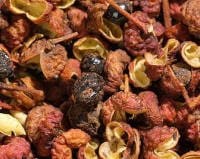Szechwan pepper, also known as Sichuan pepper or Chinese prickly ash, isn’t your typical peppercorn. With its tongue-tingling sensation and citrusy aroma, this spice is a hallmark of Sichuan cuisine and a must-have for adventurous cooks. Let’s dive into the world of Szechwan pepper and discover why it’s such a fascinating and essential spice.
What is Szechwan Pepper?
Despite its name, Szechwan pepper is not related to black or white pepper. It comes from the dried husks of the prickly ash tree (Zanthoxylum), native to China. The spice has a distinctive flavour profile: slightly lemony, mildly earthy, and famously numbing.
The unique “numbing” sensation, known as má, comes from compounds in the husks that interact with your sensory nerves, creating a tingling buzz on your tongue. This sensation, combined with heat from chillies, is a signature of Sichuan cuisine’s “numbing and spicy” (málà) flavour.
Where is Szechwan Pepper Used?
Szechwan pepper is a cornerstone of Sichuan cooking but is also popular in other Asian cuisines:
- Sichuan Cuisine: Essential in dishes like mapo tofu, kung pao chicken, and hot pot broths.
- Spice Blends: A key ingredient in Chinese five-spice powder and Japanese shichimi togarashi.
- Marinades and Rubs: Used to flavour meats like duck, pork, and lamb.
- Noodles and Stir-Fries: Adds a unique zing to noodle dishes and vegetable stir-fries.
- Snacks and Pickles: Often sprinkled over roasted nuts, chips, or added to pickled vegetables.
What Does Szechwan Pepper Taste Like?
Szechwan pepper has a complex flavour profile:
- A bright, citrusy aroma similar to lemon or lime.
- A mild, warm heat that’s less sharp than chilli peppers.
- A tingling, buzzing sensation that feels like tiny sparks dancing on your tongue.
This combination makes Szechwan pepper both exciting and unforgettable.
How to Use Szechwan Pepper in Cooking
- Toast and Grind: Toast Szechwan peppercorns in a dry pan until aromatic, then grind them into a powder for use in sauces, stir-fries, or marinades.
- Infused Oil: Heat the peppercorns in oil to create a fragrant Szechwan pepper oil for drizzling over dishes.
- Seasoning: Sprinkle ground Szechwan pepper over roasted potatoes, popcorn, or even chocolate desserts for a surprising twist.
- Broths and Stews: Add whole peppercorns to soups and stews for a subtle numbing effect.
- Spice Mixes: Combine with salt to make Szechwan pepper salt, a versatile seasoning for fried foods.
Health Benefits of Szechwan Pepper
Szechwan pepper isn’t just flavourful—it also offers potential health benefits:
- Rich in Antioxidants: Helps combat oxidative stress and inflammation.
- Digestive Aid: Traditionally used to improve digestion and appetite.
- Pain Relief: The numbing effect can help soothe minor mouth discomfort.
- Boosts Circulation: Contains compounds that may improve blood flow.
- Immune Support: Its antimicrobial properties can help fight off infections.
Fun Facts About Szechwan Pepper
- In ancient China, Szechwan pepper was used more for medicinal purposes than cooking.
- The spice is featured in Sichuan cuisine’s legendary “málà” dishes, which combine numbing Szechwan pepper with fiery chillies.
- Some chefs use Szechwan pepper in desserts, pairing its citrusy aroma with chocolate or fruit.
- It’s one of the few spices that activates your touch sensors, creating its signature buzzing sensation.
How to Choose and Store Szechwan Pepper
When buying Szechwan pepper, look for husks that are bright red or reddish-brown and free of seeds (the seeds can be bitter). Store it in an airtight container away from heat and light to preserve its potency.
Final Thoughts
Szechwan pepper is more than just a spice—it’s an experience. Its unique numbing sensation and vibrant flavour make it a standout ingredient that can elevate your dishes to a whole new level.
Whether you’re crafting a traditional Sichuan dish or experimenting with bold new recipes, Szechwan pepper is sure to add excitement to your cooking. Ready to bring the buzz to your kitchen? Give it a try!

